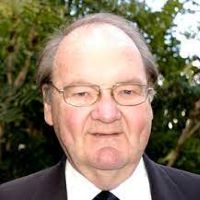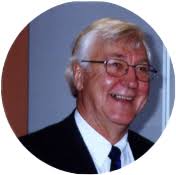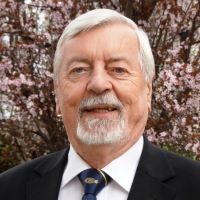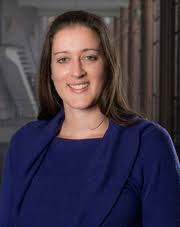The Royal Society of New South Wales Citation
On this page:
About the Citation
The Royal Society of New South Wales Citation was introduced in 2019. It is awarded to a Member or Fellow of the Society who has made significant contributions to the Society, but who has not been recognised in any other way. The Awards Committee considers nominations made by a Member or Fellow. A maximum of three Citations in any one year may be awarded.
Recent Citation Recipients
2021 Citation Recipients
The Honourable John Dowd AO QC FRSN
 Having previously served in prominent roles in the NSW Parliament and NSW Government, in 2002, The Honourable John Dowd AO QC FRSN was elected as Chancellor of Southern Cross University, serving until his retirement in 2014. In 2005, he was appointed Protection Ambassador for ActionAid Australia (previously AUSTCARE) and became a Director of the organisation in 2008 and President in 2009. In May 2011, Dowd launched The Justice Campaign in a show of support for human rights and justice with a focus on alleged abuses at Guantanamo Bay, Abu Ghraib, and elsewhere with a particular focus on David Hicks.
Having previously served in prominent roles in the NSW Parliament and NSW Government, in 2002, The Honourable John Dowd AO QC FRSN was elected as Chancellor of Southern Cross University, serving until his retirement in 2014. In 2005, he was appointed Protection Ambassador for ActionAid Australia (previously AUSTCARE) and became a Director of the organisation in 2008 and President in 2009. In May 2011, Dowd launched The Justice Campaign in a show of support for human rights and justice with a focus on alleged abuses at Guantanamo Bay, Abu Ghraib, and elsewhere with a particular focus on David Hicks.
John Dowd provided the Royal Society of NSW with outstanding service in 2020 when he provided extensive pro bono legal advice over an extended period of time on the revision of the Society’s Rules which had not been comprehensively reviewed since 1968. This exercise was complex and extensive and involved liaison with a wide range of members of the Society. It resulted in a modernised set of Rules which will stand the Society in good stead for many years to come. This outcome could not have been achieved without his input.
Mr Hubert Regtop MRSN
 Hubert Regtop MRSN is a biochemist and microbiologist with a Master of Science from the University of NSW (1973). He has a long and esteemed career as a university lecturer, research fellow, and research director of publicly listed companies, receiving multi-million dollar grants, and responsible for hospital funded projects and partnerships with universities in the US and UK. In the mid-nineties, he was responsible for introducing standardised herbs in Australia. As a director of Trilogie Pty Ltd, established in 1994, he currently consults and lectures to major health food companies, doctors, and pharmacists in Australia, on the role of nutrition in medicine. He has authored twenty-two publications and has had twenty-three patents approved. He has been a long-standing Chair of the Society’s Southern Highlands Branch to which he has made a significant contribution over ten years maintaining an active branch with a strong events program.
Hubert Regtop MRSN is a biochemist and microbiologist with a Master of Science from the University of NSW (1973). He has a long and esteemed career as a university lecturer, research fellow, and research director of publicly listed companies, receiving multi-million dollar grants, and responsible for hospital funded projects and partnerships with universities in the US and UK. In the mid-nineties, he was responsible for introducing standardised herbs in Australia. As a director of Trilogie Pty Ltd, established in 1994, he currently consults and lectures to major health food companies, doctors, and pharmacists in Australia, on the role of nutrition in medicine. He has authored twenty-two publications and has had twenty-three patents approved. He has been a long-standing Chair of the Society’s Southern Highlands Branch to which he has made a significant contribution over ten years maintaining an active branch with a strong events program.
Mr Richard Wilmott MRSN
![]() Richard Wilmott MRSN is recognised for his significant service to the Society as Treasurer and Council Member over many years, especially as the pandemic began to impact business continuity and operations of the Society from early 2020.
Richard Wilmott MRSN is recognised for his significant service to the Society as Treasurer and Council Member over many years, especially as the pandemic began to impact business continuity and operations of the Society from early 2020.
2020 Citation Recipient
Emeritus Professor Heinrich Hora FRSN FAIP FInstP
 The Royal Society of NSW Citations are awarded to a Member or Fellow of the Society who has made significant contributions to the Society, but who has not been recognised in any other way. A maximum of three Citations may be awarded in any one year.
The Royal Society of NSW Citations are awarded to a Member or Fellow of the Society who has made significant contributions to the Society, but who has not been recognised in any other way. A maximum of three Citations may be awarded in any one year.
Emeritus Professor Heinrich Hora, of the UNSW (Sydney), has served the Royal Society of New South Wales with distinction over many years. Professor Hora is a former Vice-President and Councillor of the Society and is a current member of the Fellows and Members Assessment Committee, to which he has made significant contributions over several years. In that role, he has helped ensure that the most talented and qualified individuals across many fields join the ranks of the Fellowship of the Society. In addition to his extensive service to the Society, Professor Hora is a noted theoretical physicist who has made and continues to make significant contributions to solid state physics, the optical properties of plasma, and non-linear dynamics with the application of lasers to the production of nuclear fusion energy.
2019 Citation Recipients
Dr Erik Waldemar Aslaksen FRSN
Erik W. Aslaksen FRSN is a senior, highly experienced systems engineer having worked in the US, Switzerland and Australia in fields as diverse as microwave components, power electronics, quantum electronics and communications, in areas ranging from basic research to corporate management. He has ongoing involvement in transport infrastructure and the design of industrial plant and is the author of five books (one with W.R. Belcher) and over seventy papers. His book, The Social Bond (Springer 2018) brings his engineering, systems approach to society as a whole. He will continue this theme with The Stability of Society (expected mid 2020). With these books, Dr Aslaksen continues the Enlightenment tradition of the RSNSW.
Dr Aslaksen was a member of the Council of the RSNSW from 2013 to 2019 and during that period was a tireless worker for the Society. He worked closely with The Association Specialists during the transition establishing outsourced back-office services for the Society and was instrumental in developing the relationship and ensuring that the transition was seamless. He served energetically on the Executive Committee and continues to be a highly efficient Secretary of the Fellows Assessment Committee.
Prof. E. James Kehoe FRSN
Professor E. James Kehoe FRSN is a behavioural neuroscientist whose areas of interest are associative learning, its neural substrates, and neural network models. He has worked in instructional design, researching working memory, schema formation and computer-based learning. He is a senior officer in the Australian Army Reserve, advising on character and values, and teamwork and leadership development.
Professor Kehoe was an enthusiastic member of Council from 2016 to 2018. The particular contributions that Professor Kehoe made to the renaissance of the Society were editing The Bulletin (2015–17) and chairing the Awards Committee (2016–19). Drawing on his extensive experience in newspaper publishing early in his career, he steered The Bulletin in a direction that gained a substantial readership. This publication is an important means of communicating to members and to the broader community and was an important component of publicising the progress that the Society was making across a range of activities. Professor Kehoe continued and nurtured our association with the Chief Scientist and Engineer of NSW and the yearly meeting of Deans of Science and Engineering to advise the Awards Committee.
2019 Malcolm McIntosh Prize for Physical Scientist of the Year
Associate Professor Elizabeth New FRSN
 The Royal Society of NSW is delighted that one of its Fellows and the recipient of its 2018 Edgeworth David Medal, Associate Professor Elizabeth New from the University of Sydney, has been awarded the 2019 Malcolm McIntosh Prize for Physical Scientist of the Year. The Society congratulates Elizabeth New on this momentous achievement, and the recognition of the impact of her outstanding research.
Professor New, a chemical biologist, was awarded the Malcolm McIntosh Prize at the Prime Minister's Science Prizes ceremony held at Parliament House, Canberra on 16 October. This prize recognises exceptional, early-career achievements in the physical sciences made within 10 years of PhD graduation, with the recipient receiving $50,000 in prize money, a medallion, a lapel pin, and a certificate. In the case of Professor New, this recognition was for her pioneering work in developing new chemical imaging tools to observe healthy and diseased cells.
The Royal Society of NSW is delighted that one of its Fellows and the recipient of its 2018 Edgeworth David Medal, Associate Professor Elizabeth New from the University of Sydney, has been awarded the 2019 Malcolm McIntosh Prize for Physical Scientist of the Year. The Society congratulates Elizabeth New on this momentous achievement, and the recognition of the impact of her outstanding research.
Professor New, a chemical biologist, was awarded the Malcolm McIntosh Prize at the Prime Minister's Science Prizes ceremony held at Parliament House, Canberra on 16 October. This prize recognises exceptional, early-career achievements in the physical sciences made within 10 years of PhD graduation, with the recipient receiving $50,000 in prize money, a medallion, a lapel pin, and a certificate. In the case of Professor New, this recognition was for her pioneering work in developing new chemical imaging tools to observe healthy and diseased cells.
The research of Professor New has led to the development of different types of fluorescent sensors which make possible, at the molecular level, the observation of how cells cycle and change through events and over time. While existing imaging systems such as ultrasound and MRI provide valuable structural information, they are unable to characterise the nature and distribution of chemicals within the cell. It is here that the fluorescent sensors developed by Professor New make possible the observation of complex chemical processes within cells, enabling an understanding of how cells cycle through oxidative events over long periods, and in turn opening up potential breakthrough treatments for diseases associated with ageing (e.g., cardiovascular, cancer, and diabetes) that afflict 50% of Australians and which are responsible for 85% of deaths.
More on the oustanding achievements and portfolio of work of Associate Professor Elizabeth New can be found on the Prime Minister's Prizes for Science website.
Contents of JProcRSNSW, Vol. 152, Part 2, December 2019
The complete Volume 152, Part 2, December 2019.
Robert E. Marks
Editorial: "The Old One does not play at dice"
Journal & Proceedings of the Royal Society of New South Wales 152: 157-159, 2019.
Submitted Papers:
Gary A. Rendsburg
A Hebrew "Book within Book" at Fisher Library, University of Sydney
Journal & Proceedings of the Royal Society of New South Wales 152: 160-187, 2019.
Benjamin W. B. Holman
The science of red meat and its importance to New South Wales: A case study
Journal & Proceedings of the Royal Society of New South Wales 152: 188-202, 2019.
Louise Anemaat
Drawing in the Colony
Journal & Proceedings of the Royal Society of New South Wales 152: 203-215, 2019.
Commissioned Papers:
John C. H. Spence
Speed limit: how the search for an absolute frame of reference in the Universe led to Einstein’s equation E=mc² — a history of measurements of the speed of light
Journal & Proceedings of the Royal Society of New South Wales 152: 216-241, 2019.
Robert Burford
Polymers: a historical perspective
Journal & Proceedings of the Royal Society of New South Wales 152: 242-250, 2019.
Reprinted Paper:
Barbara J. Gillam
Figure-ground and occlusion depiction in early Australian Aboriginal bark paintings and
Appendices (on-line only)
Journal & Proceedings of the Royal Society of New South Wales 152: 251-267, 2019.
PhD Thesis Abstracts:
Doan Khue Dung Dang
Efficient Hamiltonian Monte Carlo for large data sets by data subsampling
Journal & Proceedings of the Royal Society of New South Wales 152: 268, 2019.
Jade D. Frost
First impressions bias on sound sequence learning on multiple timescales: an order-driven phenomenon in auditory mismatch negativity
Journal & Proceedings of the Royal Society of New South Wales 152: 269, 2019.
Daniel McIlroy
The rôle of mitochondrial DNA in the post-injury inflammatory response following major trauma
Journal & Proceedings of the Royal Society of New South Wales 152: 270-272, 2019.
Sally Patfield
On "being first:" reconsidering Australian higher education equity policy through a comprehensive analysis of the aspirations of prospective first-in-family students
Journal & Proceedings of the Royal Society of New South Wales 152: 273-274, 2019.
Trong Toan Tran
Quantum emission from hexagonal boron nitride
Journal & Proceedings of the Royal Society of New South Wales 152: 275, 2019.
Obituary:
Stuart Macintyre
Ann Veronica Helen Moyal AM, FRSN, FAAH (1926-2019)
Journal & Proceedings of the Royal Society of New South Wales 152: 276-278, 2019.
Proceedings, 2019:
Programmes of events in Sydney, the Southern Highlands, and the Hunter; the Awards 2019; the Gazetting of Fellows, February 2019.
Journal & Proceedings of the Royal Society of New South Wales 152: 279-289, 2019.
Establishment of the Hunter Branch of the Royal Society of NSW
Inaugural meeting (October 2019)
The inaugural meeting of the Hunter Branch of the Royal Society of NSW was held at the Newcastle Club on Wednesday 9 October 2019, with the President of the Society, Emeritus Professor Ian Sloan AO FAA FRSN, presiding. The meeting was attended by 46 Fellows, Members and guests.
Professor Sloan presented fellowship certificates to two new members from the Hunter region: Emeritus Professor Ken Dutton AM FRSN and Professor Brett Nixon FRSN.
Business of the Meeting
The meeting resolved:
- to recommend to Council that the Royal Society of NSW establish a Hunter Branch;
- that Emeritus Professor Eugenie Lumbers be appointed interim Branch representative on the RSNSW Council until a permanent appointment is made;
- that the following be elected as office bearers of the Hunter Branch
| Chair | Mr Paul Jeans (Chancellor, University of Newcastle) |
| Vice-Chair | Laureate Professor John Aitken |
| Honorary Secretary | Scientia Professor Emeritus Eugenie Lumbers |
| Honorary Treasurer | Professor George Willis |
| Committee Members | Emeritus Professor John Boulton |
| Father Andrew Doohan | |
| Mr John Dunnet | |
| Professor Brett Ninness | |
| Professor Natalie Thamwattana | |
| Mr Robert Whittaker |
Following the business of the meeting, Professor Hugh Durrant-Whyte FRS FAA FTSE FRSN, NSW Chief Scientist and Engineer, delivered a lecture on Industries of the Future.
A Speaker’s Medal was presented to Professor Durrant-Whyte by Professor Alex Zelinsky FRSN and the meeting was closed by Professor Sloan.
Invited Lecture by Professor Hugh Durrant-Whyte: Industries of the Future
The Office of the Chief Scientist and Engineer provides independent advice to the New South Wales Government on a range of environmental and economic issues, such as groundwater resources and energy security. Science engagement and outreach are also supported through such activities as the NSW Premier’s Prizes, which in the past 10 years have gone from relatively low key awards to high profile celebrations in Parliament, and the Science and Engineering Challenge. The Office also sponsors conferences and provides co-investment support for successful NSW applications for the Commonwealth Government’s Industrial Transformation Research Program.
Professor Durrant-Whyte emphasised the role of research in the “prosperity economy”. His Office supports initiatives which aim to translate the best of NSW research into industry outcomes—from quantum technologies to robotics for agricultural applications, and from advanced manufacturing to synthetic biology. These initiatives include the support of national research Centres of Excellence, National Collaborative Research Infrastructure, industry innovation networks and the new Physical Sciences Investment fund. His Office also works closely with other NSW Government Departments and Industry to develop a future industry strategy around emerging precincts, such as the proposed new Sydney Technology and Innovation Precinct.
He concluded his lecture by referring to the past and future roles of the Royal Society. He noted that outside his new office in the Warren Centre at the University of Sydney copies of the Society’s Journal dating from the late nineteenth century may be found. They contain important papers about projects significant for New South Wales at that time, and show that the Society was clearly embedded in the NSW community. We now need to return to this position of having strong links with the community and of publishing research relevant to local industries.
Contents of JProcRSNSW, Vol. 152, Part 1, June 2019
The complete Volume 152, Part 1, June 2019.
Robert E. Marks
Editorial: paradigm shifts.
Journal & Proceedings of the Royal Society of New South Wales 152: 1-4, 2019.
Submitted Paper:
Ann Moyal, with Robert Marks.
The scientists and Darwin's The Origin of Species in nineteenth century Australia. A re-evaluation.
Journal & Proceedings of the Royal Society of New South Wales 152: 5-26, 2019.
The Royal Society of NSW and Four Academies Forum: Towards a Prosperous Yet Sustainable Australia -- What Now for the Lucky Country?
The Governor, David Hurley.
Opening address.
Journal & Proceedings of the Royal Society of New South Wales 152: 27-29, 2019.
Hugh Durrant-Whyte.
Sustainability -- setting the scene.
Journal & Proceedings of the Royal Society of New South Wales 152: 30-33, 2019.
Hugh Mackay.
Why social cohension is our greatest challenge.
Journal & Proceedings of the Royal Society of New South Wales 152: 34-39, 2019.
Samantha Mostyn.
Australia's progress against the UN's Sustainable Development Goals.
Journal & Proceedings of the Royal Society of New South Wales 152: 40-46, 2019.
Graham M. Turner.
Is a sustainable future possible?
Journal & Proceedings of the Royal Society of New South Wales 152: 47-65, 2019.
Brian Czech.
The trophic theory of money: principles, corollaries, and policy.
Journal & Proceedings of the Royal Society of New South Wales 152: 66-81, 2019.
Ashley Brinson.
The circular economy: international case studies and best practice.
Journal & Proceedings of the Royal Society of New South Wales 152: 82-93, 2019.
Jacky Hodges, Steven May, and Lisa Wardlaw-Kelly.
Unearthing a new frontier: the ABS Environmental-Economic Accounts.
Journal & Proceedings of the Royal Society of New South Wales 152: 94-100, 2019.
Toby Walsh.
Australia's AI future.
Journal & Proceedings of the Royal Society of New South Wales 152: 101-104, 2019.
Mary-Ann Williams.
The AI race: will Australia lead or lose?.
Journal & Proceedings of the Royal Society of New South Wales 152: 105-114, 2019.
James Morley.
Australia, the safe.
Journal & Proceedings of the Royal Society of New South Wales 152: 115-120, 2019.
Edward Holmes.
The future of biosecurity in Australia.
Journal & Proceedings of the Royal Society of New South Wales 152: 121-128, 2019.
John Quiggin.
Getting climate policy back on track.
Journal & Proceedings of the Royal Society of New South Wales 152: 129-134, 2019.
Ann Williamson.
Summing up the Forum: what future the Luck Country?
Journal & Proceedings of the Royal Society of New South Wales 152: 135-139, 2019.
Thesis Abstracts:
David J. Carter.
Responsibility for iatrogenic deaths in Australian criminal law.
Journal & Proceedings of the Royal Society of New South Wales 152: 140-142, 2019.
Grace L. Causer.
Functional magnetic interface phenomena in nano-architectures.
Journal & Proceedings of the Royal Society of New South Wales 152: 143-144, 2019.
Veronica Jarocki.
Mycoplasma hyponeumoniæ proteases: investigating their role in pathogenesis and chronic infection.
Journal & Proceedings of the Royal Society of New South Wales 152: 145-146, 2019.
Matthew B. O'Rourke.
The use of Matrix Assisted Laser Desorption Ionisation Time of Flight Mass Spectrometry (MALDI-TOF-MS) and associated technologies for the study of disease pathogenesis and advanced diagnostics.
Journal & Proceedings of the Royal Society of New South Wales 152: 147, 2019.
Marcelle Townsend-Cross.
Dificult knowledge and uncomfortable pedagogies: student perceptions and experiences of teaching and learning in Critical Indigenous Australian Studies.
Journal & Proceedings of the Royal Society of New South Wales 152: 148, 2019.
Trong Toan Tran.
Quantum emissions from hexagonal boron nitride.
Journal & Proceedings of the Royal Society of New South Wales 152: 149, 2019.
Obituary
Donald Hector.
Noel Sydney Hush, DistFRSN, 1924-2019.
Journal & Proceedings of the Royal Society of New South Wales 152: 150-152, 2019.
The Royal Society of New South Wales Awards for 2019:
The Clarke Medal, The Edgeworth David Medal, The James Cook Medal, The Warren Prize, The History and Philosophy of Science Medal, RSNSW Scholarships, The Jak Kelly Award.
Journal & Proceedings of the Royal Society of New South Wales 152: 153- , 2019.

